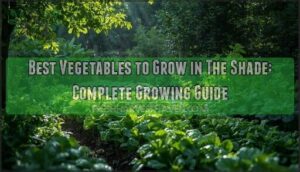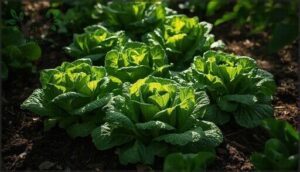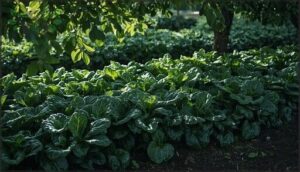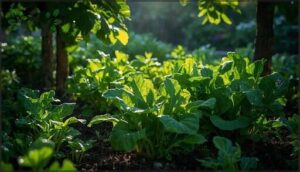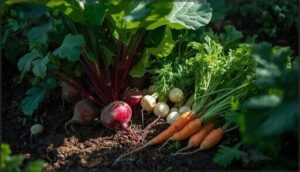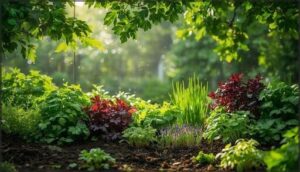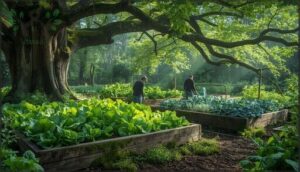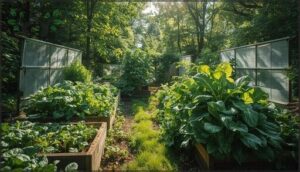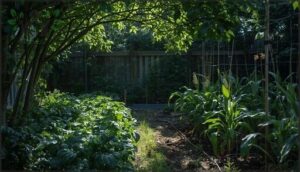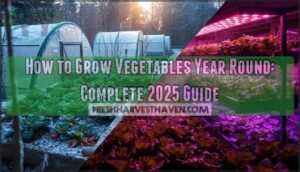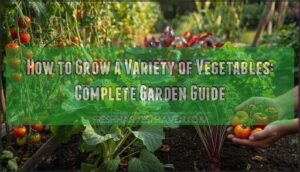This site is supported by our readers. We may earn a commission, at no cost to you, if you purchase through links.
Most gardeners treat shady corners like the lost socks of the backyard—untouchable, hopeless, doomed to weeds and wishful thinking. But toss a handful of spinach or lettuce seeds into the mix, and suddenly those dim nooks turn generous.
Lettuce, kale, and even a plucky parsley plant thrive on borrowed light, sending up leaves as sweet and tender as anything from the sunniest beds. The real magic? Shade cuts heat stress and slows summer wilting, serving up harvests when sun-lovers are already calling it quits.
Worried you’ll end up with stunted greens and tiny roots? Let’s turn those shadows into a harvest worth bragging about.
Table Of Contents
- Key Takeaways
- What Makes a Vegetable Shade-Tolerant?
- Best Leafy Greens for Shade Gardens
- Top Root Vegetables to Grow in Shade
- Shade-Friendly Herbs and Specialty Crops
- Essential Shade Vegetable Growing Tips
- Advanced Shade Gardening Techniques
- Common Mistakes and What Not to Grow in Shade
- Frequently Asked Questions (FAQs)
- What is the most shade tolerant vegetable?
- What will grow in 100% shade?
- Which vegetables require the least amount of sun?
- Do any edible plants grow in full shade?
- Can vegetables grow in the shade?
- What vegetables can grow in partial shade?
- Which vegetables are most tolerant of shade?
- What vegetables grow in a shady yard?
- Which vegetables and herbs grow well in shade?
- Can vegetables grow in shade?
- Conclusion
Key Takeaways
- Leafy greens like spinach, lettuce, and kale thrive in partial shade, often yielding sweeter, tenderer leaves and avoiding heat stress.
- Many root vegetables—beets, radishes, carrots, and turnips—can grow well in shadier spots, producing flavorful crops even with less intense sunlight.
- Shade-tolerant herbs such as cilantro, parsley, dill, and mint not only survive but can actually flourish in low-light conditions, providing extended harvests.
- Smart shade gardening means measuring sun exposure, improving soil with compost and mulch, and choosing crops bred for shade to turn overlooked corners into productive harvests.
What Makes a Vegetable Shade-Tolerant?
Not all vegetables need full sun to thrive. Some crops have adapted to lower light conditions and can actually perform better when they’re shielded from intense rays.
Understanding what makes these plants shade-tolerant starts with knowing how sunlight, growth patterns, and your garden’s conditions work together.
Sunlight Requirements for Vegetables
Before you plan your shade garden, you need to understand how light intensity shapes what you can grow. Shade-tolerant plants have evolved to optimize their photosynthesis rate even when daily sun hours are limited, giving you real freedom to transform those tricky spots.
- Full sun crops (tomatoes, peppers) demand 6–8 hours of direct light—anything less tanks their yield
- Partial shade vegetables thrive with 3–6 hours, maintaining 60–75% of full-sun production
- Lettuce varieties hit peak performance at 4–6 hours, then decline 15% per extra hour in heat
- Spinach actually outperforms in shade, yielding 20–40% more fresh weight than stressed sun-grown plants
- Shade tolerance varies wildly—kale keeps 70–85% yields with just 2–5 hours of sunlight
How Shade Affects Growth and Yield
Understanding shade tolerance starts with photosynthesis rates—your leafy greens convert light into growth, but shade gardening means accepting trade-offs. Under partial shade, light intensity drops and most shade-tolerant vegetables produce 20–40% less biomass than sun-grown counterparts.
Cool season crops handle this better, with yield factors like leaf area expansion compensating through slower, steadier growth patterns that shade-tolerant plants have mastered.
When planning a shade garden, consider using research subtopics to organize and focus your gardening strategy.
Benefits of Growing in Shade
Shade gardening offers surprising advantages beyond simple yield calculations. You’ll conserve soil moisture—transpiration drops 15–25% in shaded beds—while heat stress becomes nearly a non-issue during scorching summers. Your leafy greens stay tender longer, and you can diversify crop rotations with shade-tolerant vegetables that wouldn’t survive in full sun.
Shade gardening conserves moisture, keeps greens tender, and lets you grow varieties that would struggle under the harshness of full sun
- Extended harvest windows give you 1–3 extra weeks of production
- Pest control improves modestly, with aphid populations declining 10–30%
- Seedling survival rates jump 20–35% in protected microclimates
- Crop diversity increases, fitting 2–4 additional growing vegetables in shade per season
Best Leafy Greens for Shade Gardens
Leafy greens are your best friends in shade gardening. They actually prefer cooler conditions and won’t throw a fit when sunlight is limited.
Let’s look at which varieties will give you the best harvest in those shadier spots.
Lettuce Varieties for Partial Shade
Not all lettuce is created equal when it comes to shade tolerance. Butterhead and Batavia types produce 20–40% more leaf area under partial shade, making them top performers for vegetable garden spots with limited light. Romaine delays bolting by up to two weeks in dappled shade, while leaf lettuce varieties show impressive growth rates even with reduced sun exposure.
| Lettuce Type | Shade Performance |
|---|---|
| Butterhead/Batavia | 20–40% higher leaf area in 3–4 hours shade |
| Romaine | 15–25% better bolting resistance; delays flowering 7–14 days |
| Leaf Lettuce | 10–30% greater biomass under 2–6 hours shade |
Choose shade-tolerant cultivars with proven seed viability—they’ll reward you with crisper leaf texture and extended harvests. Your leafy greens can truly thrive where sun-lovers struggle.
Spinach and Kale Performance
Both spinach and kale deliver impressive results in partial shade. Spinach yield reaches 40–70% of full-sun production under 50% shade, with bolting prevention improving by 10–25% during warm periods. Kale varieties maintain 60–85% of their full-sun fresh weight in similar conditions. Dark-green spinach cultivars and savoyed kale types show 15–25% higher shade tolerance, making them your best picks for leafy greens in low-light spots.
Understanding the importance of a systematic review process approach is essential for evaluating the best vegetables to grow in shade.
Arugula and Bok Choy in Low Light
Arugula thrives in partial shade, reducing harvest time by 14–21 days while maintaining 60–75% of its biomass through enhanced low light photosynthesis. Bok choy flavor enhancement occurs naturally in shade, with delayed bolting extending your harvest window by 10–25 days.
These shade-tolerant leafy greens adapt remarkably well, with arugula bolting prevention a major win. Proper microclimate management and choosing shade-tolerant breeding lines boost your yields even when sunlight is limited.
Top Root Vegetables to Grow in Shade
Root vegetables are surprisingly forgiving in shade—many actually perform better with less intense sun. You’ll get sweeter beets, crisper radishes, and carrots that won’t bolt at the first sign of heat.
Let’s look at which root crops thrive in those shadier corners of your garden and how to help them develop strong, flavorful roots.
Beets and Radishes for Shady Spots
Quick-growing crops like beets and radishes thrive in partial shade, though you’ll see 15–30% smaller roots compared to full sun—Detroit Dark Red holds its color beautifully despite reduced size.
Radishes actually mature faster under cooler, shaded conditions, reaching harvest in 20–25 days while dodging that dreaded bolting. Cherry Belle performs especially well with 4–6 hours of direct light.
Soil moisture stays more stable, cutting your watering routine by roughly 15%.
Carrots and Turnips in Partial Shade
Carrots and turnips handle partial shade surprisingly well. Nantes and Chantenay carrot varieties show only 10–25% yield loss with 3–5 hours of sun, while Purple Top White Globe turnips maintain over 70% of full-sun production.
Expect roots 12–18 mm smaller, but flavor stays solid. French Breakfast carrots demonstrate remarkable shade tolerance among root vegetables, and maturity extends just 7–14 days in these cooler conditions.
Tips for Root Development in Shade
Root initiation in shade happens 3–7 days earlier thanks to altered hormonal responses—mainly auxin shifting priorities underground.
Keep soil moisture consistent; shaded beds hold water 10–20% longer, so back off on irrigation. Boost nutrient uptake with compost or mycorrhizal inoculants, which can lift phosphorus absorption by 15–30%.
For shade adaptation, choose compact shade-tolerant plants and use reflective mulch to capture every photon.
Shade-Friendly Herbs and Specialty Crops
You don’t have to stick with just vegetables when planning your shade garden. Several herbs actually prefer a bit of relief from intense sun, delivering better flavor and slower bolting when grown in partial shade.
Let’s look at which herbs thrive in low-light conditions and a few specialty crops that might surprise you.
Cilantro, Parsley, and Dill in Shade
You’ll find cilantro, parsley, and dill surprisingly resilient in partial shade—perfect shade tolerant herbs for light filtering conditions. These shade tolerant plants adapt beautifully to gardening in partial shade, with cilantro bolting 20–40% less in cooler soil temperature. Here’s what makes them winners:
- Cilantro extends harvest by 7–14 days under shade
- Parsley maintains 50–70% leaf production in low light
- Dill delays flowering 7–14 days, prolonging usable growth
- Water conservation improves with 12–18% reduced evaporation
- Herb selection for shade offers consistent, flavorful yields
Other Herbs Suitable for Low Light
Beyond cilantro and dill, you’ve got serious options for low-light planting. Mint thrives in humid shade with 20–50% better survival rates than sun-grown patches—perfect for shade gardening tips beginners love. Chives show minimal yield loss (just 10–30%) in partial shade, while thyme maintains essential oils despite 30–40% slower growth. Parsley’s your workhorse here, keeping 40–60% leaf area with consistent herb shade tolerance.
| Herb | Shade Herb Benefits | Light Shade Strategies |
|---|---|---|
| Mint | 20–50% higher survival in shade | Plant in humid, shaded containers |
| Chives | Only 10–30% biomass reduction | Pair with taller shade-tolerant crops |
| Thyme | Maintains oil quality in low light | Extend spacing for airflow |
Unique Specialty Crops for Shade
Want to push your shade gardening tips further? Wasabi demands 75% shade cover and stays cool at 8–20°C—perfect for forest ramps and miner’s lettuce companions. Microgreens thrive under low light (50–100 μmol m⁻² s⁻¹), delivering fresh greens fast. Shade structures transform challenging spots into productive zones for shade-tolerant vegetables and cool-season crop gardening adventures.
- Shade Wasabi – Requires 75% shade cover with high humidity for authentic flavor.
- Forest Ramps – Wild leeks needing seven years to mature under a dense canopy.
- Miner’s Lettuce – Self-seeding perennial for deep forest shade.
- Microgreens – Fast-growing leafy green vegetables perfect for low-light production.
Essential Shade Vegetable Growing Tips
Growing vegetables in shade isn’t hard, but you’ll need a few smart strategies to set your plants up for success. The right preparation makes all the difference between scraggly, disappointing crops and a thriving, productive garden.
Let’s walk through the essential techniques that’ll help you make the most of every ray of sunlight your shady spots receive.
Measuring and Maximizing Sun Exposure
Track your garden’s sunlight exposure by checking every hour from dawn to dusk—you’ll discover which spots truly qualify as partial shade (3–6 hours) versus full sun. Digital light meters reveal daily light integral values of 2–6 mol m⁻² d⁻¹ in shade, helping you position shade-tolerant vegetables strategically.
White walls or reflective mulches boost under-canopy light by 5–20%, maximizing photosynthetic performance without relocating beds.
Soil Preparation and Moisture Control
Loamy soil with 2–3 inches of organic matter delivers 15–20% better moisture retention and keeps roots 1–2°C cooler—your shade-tolerant vegetables will thank you.
Mix in compost annually to raise available nitrogen by 15–25%, then apply 2–3 inches of mulch to stabilize moisture fluctuations by 22%.
Drip irrigation with sensors cuts water use 25–40% while boosting yields in partial shade.
Starting Seeds Indoors for Success
Seed germination for shade-tolerant vegetables starts strong when you maintain 65–75°F soil temperature and run indoor lighting 14–16 hours daily—your seedlings will hit 85–95% emergence rates.
- Use shallow trays (1.5–2 inches) with light germination mix for 12–25% better results
- Target 200–400 µmol·m⁻²·s⁻¹ LED intensity to prevent leggy growth
- Transplant at 4–6 true leaves to cut transplant shock 20–30%
- Harden off gradually over 7–10 days for stronger survival
- Apply 50–75 ppm starter fertilizer for vigorous seedling care
This foundation bolsters cool season crop gardening and leafy green gardening in partial shade environments.
Advanced Shade Gardening Techniques
Once you’ve got the basics down, you can push your shade garden even further with a few smart strategies. These techniques help you squeeze more yield out of limited light while making the most of every square inch.
Let’s look at three practical ways to level up your shade-gardening game.
Companion Planting for Shade Efficiency
Pairing shade-tolerant vegetables with the right companions can push your yield up by 14–22%. Try planting leafy greens near nitrogen-fixing legumes—soil N jumps 12–28%, feeding your crops naturally.
Marigolds and nasturtiums cool soil by 3.2°C under partial shade, protecting tender leaves.
These shade companions create a thriving intercrop system, turning limited light into surprising productivity through smart vertical gardening and companion planting strategies.
Multi-Height and Reflective Strategies
By layering your shade tolerant vegetables at different heights, you’ll capture 15–35% more light for leafy greens and root crops. Vertical gardening with trellises opens up lower layers, while reflective mulch boosts light diffusion by 10–25%.
White ground covers scatter photons upward, feeding partial shade beds with extra radiation.
These shade optimization tricks transform layered planting into a high-yield system for shade tolerant vegetable gardening.
Using Containers and Plant Caddies
Ever wish your greens could chase the sun? Container Gardening with caddy systems lets you move shade-tolerant vegetables—like leaf lettuce and kale—to the brightest spots. Vertical planting makes every inch count, while smart soil management and reflective surfaces enhance growth.
Shade optimization with plant caddies turns even partial shade into a productive haven, whether you’re living curbside or hillside.
Common Mistakes and What Not to Grow in Shade
Not every vegetable will thrive in the shadows, and pushing sun-lovers into shade usually ends in disappointment.
You’ll also want to watch for telltale signs that your plants aren’t getting enough light, plus steer clear of common watering mistakes that invite disease.
Let’s cover what to avoid so you can set your shade garden up for real success.
Vegetables That Require Full Sun
You can’t cheat the sun regarding tomatoes, peppers, and cucumbers—these heat-loving champions need 6–8 full sun hours daily to produce fruit. Without that exposure, your vegetable garden will yield mostly leaves and disappointment.
Even heat-tolerant lettuce won’t replace fruiting crops in your garden layout. Know your crop selection limits before planting.
Signs of Poor Shade Adaptation
Your shade-tolerant plants will tell you when they’re struggling. Watch for excessive stem stretching—that’s plant etiolation in action, with internodes lengthening 12% as they chase light. Chlorophyll decline shows up as pale, yellowing leaves, while leaf senescence accelerates.
If you spot thinning foliage, stunted growth, or delayed maturity beyond 5–12 days, you’re dealing with shade stress and growth inhibition.
Avoiding Overwatering and Disease
Shaded beds hold moisture longer, but that’s where disease prevention gets tricky. Overwatering in partial shade raises root rot risk two to three times—Pythium and Phytophthora thrive in saturated, low-light conditions. Your shade soil management and moisture monitoring strategy should include:
- Check soil 2–3 inches deep before watering
- Use drip irrigation to cut leaf wetness by 20–35%
- Apply 2–3 inch mulch for water conservation
- Guarantee proper drainage with raised beds for root health
Frequently Asked Questions (FAQs)
What is the most shade tolerant vegetable?
Think you can’t get a good harvest in the shadows? Spinach is the real champion of shade gardening.
It boasts impressive shade tolerance, maintaining vigorous leaf growth and vegetable yield even in partial shade—true crop resilience and seamless shade adaptation.
What will grow in 100% shade?
You’ll find a few hardy shade-tolerant vegetables—like Swiss chard, spinach, arugula, and baby bok choy—still producing in dense shade.
These shade-tolerant plants won’t thrive, but you’ll harvest usable greens even in full shade conditions.
Which vegetables require the least amount of sun?
Ever wonder which veggies thrive with minimal sunlight or in partial shade? Leaf lettuce, spinach, kale, bok choy, radishes, and parsley top the list for low light and shade tolerant plants, perfect for sunless gardens and lowlight gardening.
Do any edible plants grow in full shade?
No truly edible plants thrive in full shade—absolute darkness is a no-go for vegetables in shade. Even the most shade-tolerant crops or leafy greens need at least a bit of daily sun for healthy growth.
Can vegetables grow in the shade?
Picture leafy greens basking in a cool, calm patch of your yard—yes, vegetables can thrive in shade. With strategic Crop Selection and smart Garden Planning, partial shade supports Photosynthesis and vigorous growth for shade-tolerant plants and vegetables.
What vegetables can grow in partial shade?
Many shade-tolerant vegetables thrive in partial shade, including kale, lettuce, spinach, beets, radishes, and arugula.
These leafy greens and root crops often maintain solid vegetable yield, making crop selection key for successful shade gardening.
Which vegetables are most tolerant of shade?
Leafy greens reign dominant in shade gardening—lettuce, spinach, and kale deliver bountiful harvests with just 3–4 hours of sun.
Root crops like radishes and beets follow close behind, thriving as cool-season shade-tolerant plants.
What vegetables grow in a shady yard?
Your shady yard can support lettuce, kale, spinach, arugula, and bok choy with just 3–4 hours of sun.
Root crops like beets, radishes, and turnips also thrive in partial shade with proper garden planning.
Which vegetables and herbs grow well in shade?
If you’re planning a shade garden, focus on Shade Tolerant Plants like lettuce, spinach, kale, arugula, bok choy, beets, radishes, parsley, cilantro, and dill—herbs and leafy greens that thrive with thoughtful Garden Planning and Shade Strategies.
Can vegetables grow in shade?
Think of shade as a gentle filter, not a locked door—yes, vegetables can grow in shade. Shade tolerance varies, but leafy greens like spinach and kale still offer impressive vegetable yield and shade benefits with thoughtful garden planning.
Conclusion
Shade’s secret? Simple: sow smarter, savor success. Those overlooked corners brim with possibility, ready to surprise you with crisp leaves and lively roots if you choose the best vegetables to grow in the shade.
Wilted lettuce and frustrated hopes are no match for clever planting and a dash of patience. Each shadowy patch can become a stage for mild, mouthwatering greens—proof that sometimes, the sweetest harvests aren’t found in the spotlight, but quietly thrive behind the scenes.
- https://www.johnson.k-state.edu/lawn-garden/agent-articles/miscellaneous/defining-sun-requirements-for-plants.html
- https://extension.umn.edu/planting-and-growing-guides/gardening-shade
- https://gardenplanner.almanac.com/
- https://savvygardening.com/
- https://www.rareseeds.com/store/vegetables/kale/tronchuda-kale

